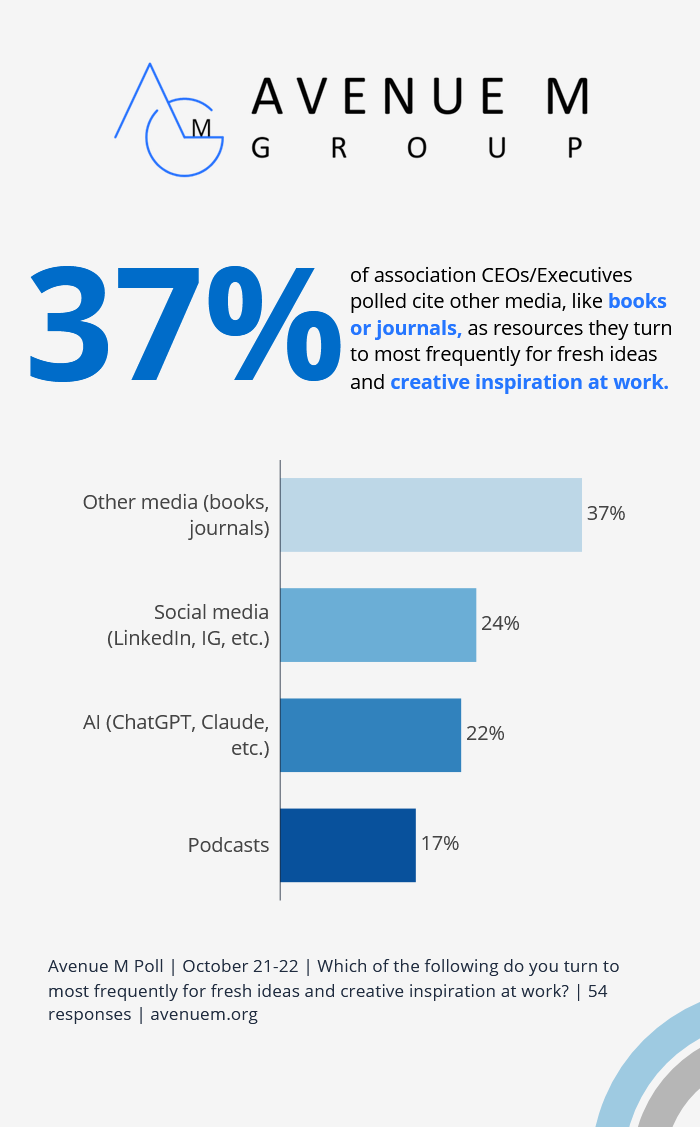 A recent Avenue M quick poll asked: Which of the following do you turn to most frequently for fresh ideas and creative inspiration at work?
A recent Avenue M quick poll asked: Which of the following do you turn to most frequently for fresh ideas and creative inspiration at work?
Here’s how respondents voted:
- Other media (books, journals): 37%
- Social media (LinkedIn, etc.): 24%
- AI (ChatGPT, Claude, etc.): 22%
- Podcasts: 17%
At first glance, it might seem surprising that traditional sources—books and journals– still lead the pack in an era defined by instant digital access. But, the poll reveals something deeper about how today’s professionals spark creativity: The best ideas often come not from what’s newest, but from where our minds slow down long enough to think differently.
The Power of Slow Thinking
Books, journals, and other long-form media demand focus. Unlike scrolling through a feed or prompting an AI, reading forces synthesis – it makes the brain connect, compare, and contextualize.
Creativity researcher Keith Sawyer found that breakthrough thinking rarely happens in the moment of input – it happens afterward, when the brain has time to wander and make unexpected connections. Reading long-form content provides that raw material and the mental space to process it.
So, while AI and podcasts may provide quick sparks, deeper sources – those that require reflection – still win when it comes to producing sustainable innovation.
AI as the New Creative Partner
That said, the large percentage of those who selected AI (nearly a quarter) is telling. Tools like ChatGPT and Claude have rapidly become creative collaborators, not just information sources.
Leaders and creatives are using AI to test ideas, draft outlines, or simulate feedback before sharing with others. It’s a new kind of brainstorming partner – one that doesn’t replace human creativity but expands the boundaries of what’s possible.
In my upcoming book, The Unexpected Power of Boundaries: Rethinking the Rules, Risks, and Real Drivers of Innovation, I explore how constraints – like a prompt’s character limit or a tool’s parameters – can actually enhance creativity. AI embodies this perfectly: It gives you boundaries, instant reactions, and infinite variations. The constraint becomes the playground.
Podcasts and Social Feeds: The Inspiration Engines
A sizable percentage also selected podcasts and social media as their tools for inspiration, with social media just beating out AI by a margin. This reflects how professionals increasingly seek inspiration through stories and shared experiences.
Podcasts create intimate access to experts and innovators, often while you’re doing other things (walking the dog, cooking dinner), allowing ideas to seep in during moments that once belonged to silence. Social media delivers the pulse of what’s current: a constant stream of micro-insights, debates, and examples of what others are trying.
But these platforms can also overload the brain. Without boundaries, inspiration turns into noise. The leaders who extract the most value use these tools intentionally: setting time limits, following select voices, and capturing only what aligns with their focus.
Finding Your Creative Mix
The poll results suggest that creativity thrives in a portfolio of inspiration. Books provide depth. Podcasts and social feeds provide connection. AI provides acceleration. The magic lies in how we combine them.
Creative leaders know when to slow down and when to speed up, when to reflect deeply and when to iterate rapidly. The mix isn’t fixed; it’s dynamic, shifting with the stage of the idea.
Putting It Into Practice
Want to build a richer creative routine? Try these small shifts:
- Pair input with reflection. After consuming new content – whether a book chapter or podcast episode – pause to capture three ideas it sparked. Reflection turns consumption into insight.
- Use AI for breadth, not depth. Ask AI to generate options or opposing perspectives, then rely on your expertise to evaluate which are worth exploring.
- Curate your social space. Follow a few voices who consistently challenge your assumptions rather than echo your beliefs.
- Create one “quiet” hour per week. No screens, no prompts, no multitasking – just time to think, synthesize, and connect ideas.
The best creative sources aren’t about where you look– they’re about how intentionally you engage. Whether it’s a podcast, a page, or a prompt, your next great idea may already be waiting. You just need to give it room to breathe.
Want to be the first to be notified about articles like this? You can learn more about Avenue M’s texting poll service HERE or sign up to participate in future text polls HERE.
Contributors: Sheri Jacobs, FASAE, CAE
Image: Sheri Jacobs. Taken in October 2025 in the Okavango Delta in Botswana – a place where Sheri finds inspiration.